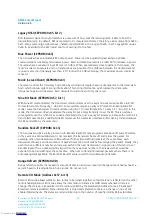
RM024 User Manual
Version 2.3
Americas: +1-800-492-2320 Option 2
Europe: +44-1628-858-940
Hong Kong: +852-2923-0610
www.lairdtech.com/wireless
16
CONN-GUIDE-RAMP24-0413
RS-485 Data Enable
The timing of the DE-RE pin varies depending on the selected interface baud rate. Prior to firmware v2.2,
these parameters are set automatically if Auto Config is enabled. If Auto Config is disabled, these values must
be set correctly, even if RS-485 Data Enable is not being used. In v2.2 and beyond these parameters are not
controlled by Auto Config, but instead by Address 0x57, bit 5.
The values to set are:
485_Delay_H: Address 0x49
485_Delay_M: Address 0x4A
485_Delay_L: Address 0x4B
To set them, use the following equation (round the result up):
Address 0x49 and 0x4A: 485H/M = 8.125 MHz / (81*Baud_Rate), quotient only
Address 0x4B: 485L = (8.125MHz / Baud_Rate) mod 81
So for 19,200 you should calculate 00 05 12.
Flow Control
Although flow control is not required for transceiver operation, it is recommended to achieve optimum
system performance and to avoid overrunning the RM024’s serial buffers. The RM024 uses separate buffers
for incoming and outgoing data.
RXD Data Buffer and CTS
As data is sent from the OEM host to the radio over the serial interface, it is stored in the RM024’s buffer
until the radio is ready to transmit the data packet. The radio waits to transmit the data until one of the
following conditions occur (whichever occurs first):
The RF packet size is reached (EEPROM address 0x5A)
An interface timeout occurs (EEPROM address 0x58)
The data continues to be stored in the buffer until the radio receives an RF Acknowledgement (ACK) from the
receiving radio (addressed mode), or all transmit retries/broadcast attempts are used. Once an ACK has been
received or all retries/attempts are exhausted, the current data packet is removed from the buffer and the
radio begins processing the next data packet in the buffer.
To prevent the radio’s RXD buffer from being overrun, we strongly recommend that the OEM host monitors
the radio’s CTS output. When the number of bytes in the RXD buffer reaches the value specified by CTS_ON
(EEPROM address 0x5C - 0x5D), the radio de-asserts (high) CTS to signal to the OEM host to stop sending
data over the serial interface. CTS is re-asserted after the number of bytes in the RXD buffer is reduced to the
value specified by CTS_OFF (EEPROM addresses 0x5E- 0x5F); signaling to the OEM host that it may resume
sending data to the transceiver.
Note: We recommend that the OEM host stop all data transmission to the radio while CTS is de-asserted
(high); otherwise potential data loss may occur.
Downloaded from
Downloaded from
Downloaded from
Downloaded from
Downloaded from
Downloaded from
Downloaded from
Downloaded from
Downloaded from
Downloaded from
Downloaded from
Downloaded from
Downloaded from
Downloaded from
Downloaded from
Downloaded from
















































